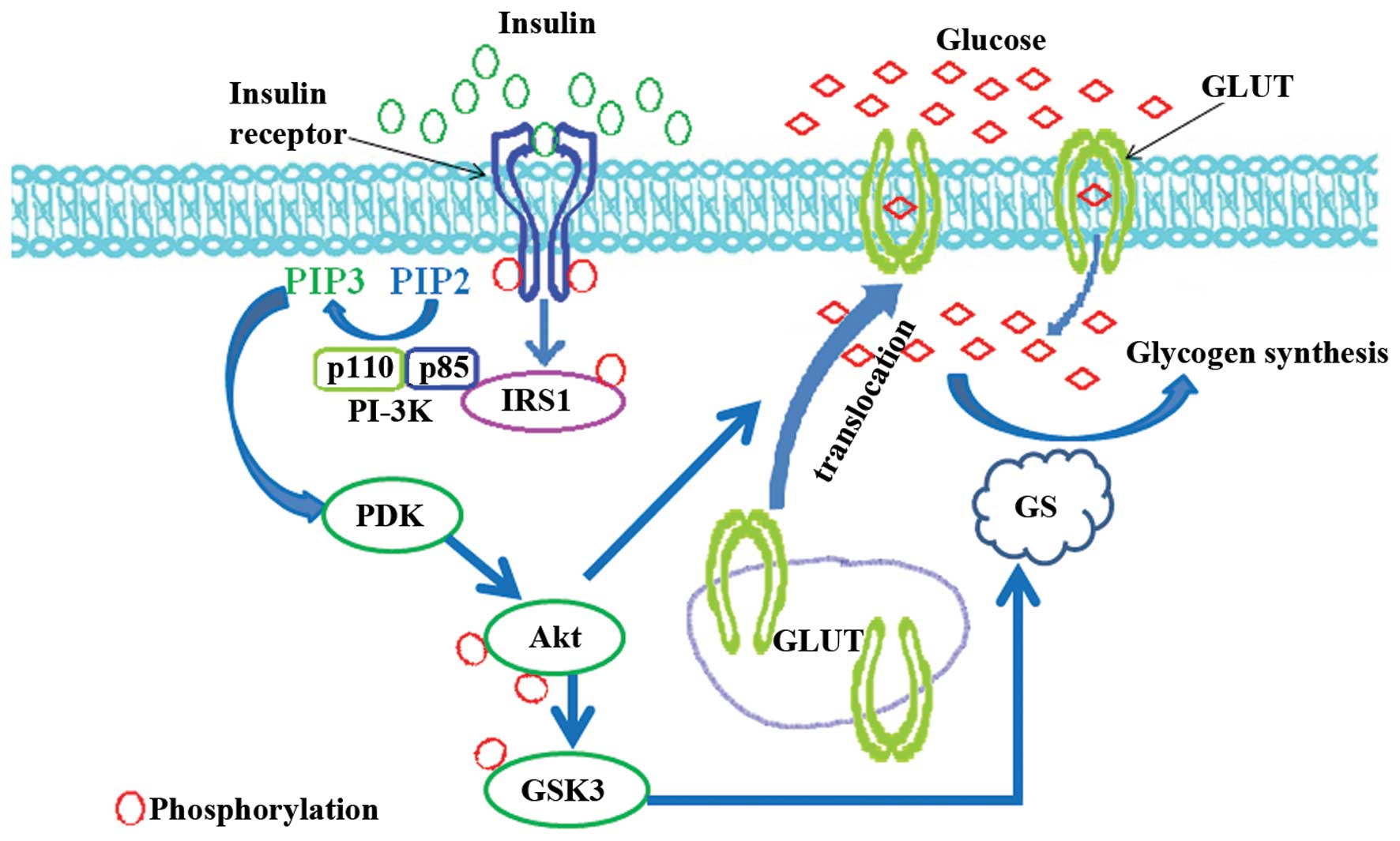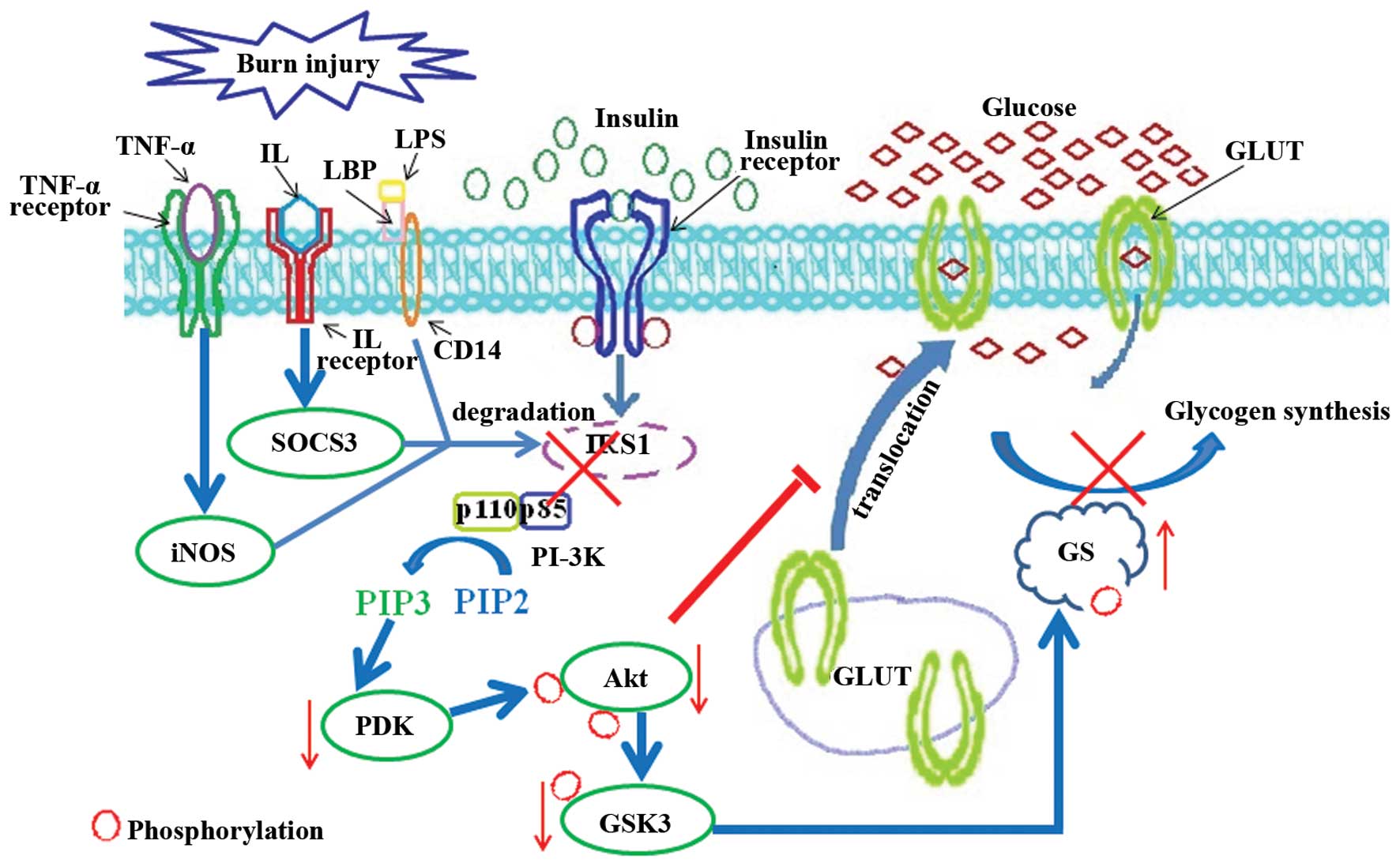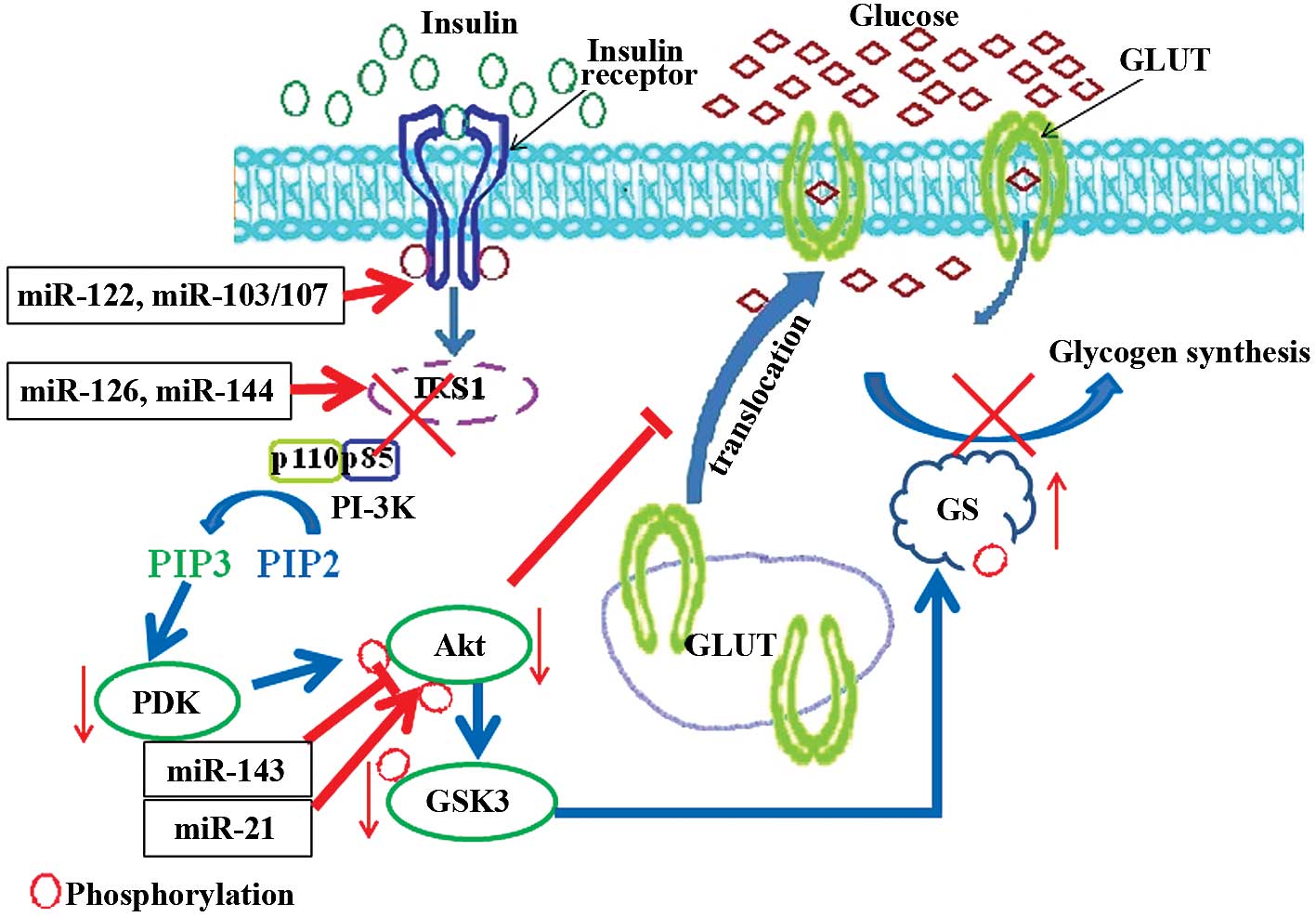The function of miRNAs and their potential as therapeutic targets in burn-induced insulin resistance (Review)
- Authors:
- Yonghui Yu
- Jiake Chai
-
Affiliations: Department of Burn and Plastic Surgery, The First Affiliated Hospital of PLA General Hospital, Beijing 100048, P.R. China - Published online on: December 5, 2014 https://doi.org/10.3892/ijmm.2014.2023
- Pages: 305-310
This article is mentioned in:
Abstract
 |
 |
 |
|
Lee RC, Feinbaum RL and Ambros V: The C. elegans heterochronic gene lin-4 encodes small RNAs with antisense complementarity to lin-14. Cell. 75:843–854. 1993. View Article : Google Scholar : PubMed/NCBI | |
|
Bentwich I, Avniel A, Karov Y, et al: Identification of hundreds of conserved and nonconserved human microRNAs. Nat Genet. 37:766–770. 2005. View Article : Google Scholar : PubMed/NCBI | |
|
Lewis BP, Burge CB and Bartel DP: Conserved seed pairing, often flanked by adenosines, indicates that thousands of human genes are microRNA targets. Cell. 120:15–20. 2005. View Article : Google Scholar : PubMed/NCBI | |
|
Lee Y, Kim M, Han J, et al: MicroRNA genes are transcribed by RNA polymerase II. EMBO J. 23:4051–4060. 2004. View Article : Google Scholar : PubMed/NCBI | |
|
Zeng Y and Cullen BR: Efficient processing of primary microRNA hairpins by Drosha requires flanking nonstructured RNA sequences. J Biol Chem. 280:27595–27603. 2005. View Article : Google Scholar : PubMed/NCBI | |
|
Andl T, Murchison EP, Liu F, et al: The miRNA-processing enzyme dicer is essential for the morphogenesis and maintenance of hair follicles. Curr Biol. 16:1041–1049. 2006. View Article : Google Scholar : PubMed/NCBI | |
|
Visone R and Croce CM: MiRNAs and cancer. Am J Pathol. 174:1131–1138. 2009. View Article : Google Scholar : PubMed/NCBI | |
|
Argyropoulos C, Wang K, McClarty S, et al: Urinary microRNA profiling in the nephropathy of type 1 diabetes. PLoS One. 8:e546622013. View Article : Google Scholar : PubMed/NCBI | |
|
van de Bunt M, Gaulton KJ, Parts L, et al: The miRNA profile of human pancreatic islets and beta-cells and relationship to type 2 diabetes pathogenesis. PLoS One. 8:e552722013. View Article : Google Scholar : PubMed/NCBI | |
|
McMichael AJ, Borrow P, Tomaras GD, Goonetilleke N and Haynes BF: The immune response during acute HIV-1 infection: clues for vaccine development. Nat Rev Immunol. 10:11–23. 2010. View Article : Google Scholar | |
|
Ono K, Kuwabara Y and Han J: MicroRNAs and cardiovascular diseases. FEBS J. 278:1619–1633. 2011. View Article : Google Scholar : PubMed/NCBI | |
|
Evers LH, Bhavsar D and Mailander P: The biology of burn injury. Exp Dermatol. 19:777–783. 2010. View Article : Google Scholar : PubMed/NCBI | |
|
Duan H, Chai J, Sheng Z, et al: Effect of burn injury on apoptosis and expression of apoptosis-related genes/proteins in skeletal muscles of rats. Apoptosis. 14:52–65. 2009. View Article : Google Scholar | |
|
Nishimura T, Nishiura T, deSerres S, Nakagawa T, Brenner DA and Meyer AA: Impact of burn injury on hepatic TGF-beta1 expression and plasma TGF-beta1 levels. J Trauma. 48:39–44. 2000. View Article : Google Scholar : PubMed/NCBI | |
|
Kowal-Vern A, Walenga JM, Hoppensteadt D, Sharp-Pucci M and Gamelli RL: Interleukin-2 and interleukin-6 in relation to burn wound size in the acute phase of thermal injury. J Am Coll Surg. 178:357–362. 1994.PubMed/NCBI | |
|
Soejima K, Traber LD, Schmalstieg FC, et al: Role of nitric oxide in vascular permeability after combined burns and smoke inhalation injury. Am J Respir Crit Care Med. 163:745–752. 2001. View Article : Google Scholar : PubMed/NCBI | |
|
Cree MG, Zwetsloot JJ, Herndon DN, et al: Insulin sensitivity and mitochondrial function are improved in children with burn injury during a randomized controlled trial of fenofibrate. Ann Surg. 245:214–221. 2007. View Article : Google Scholar : PubMed/NCBI | |
|
Cree MG, Aarsland A, Herndon DN and Wolfe RR: Role of fat metabolism in burn trauma-induced skeletal muscle insulin resistance. Crit Care Med. 35:S476–S483. 2007. View Article : Google Scholar : PubMed/NCBI | |
|
Sharp A and Clark J: Diabetes and its effects on wound healing. Nurs Stand. 25:41–47. 2010. View Article : Google Scholar | |
|
Lima MH, Caricilli AM, de Abreu LL, et al: Topical insulin accelerates wound healing in diabetes by enhancing the AKT and ERK pathways: a double-blind placebo-controlled clinical trial. PLoS One. 7:e369742012. View Article : Google Scholar : PubMed/NCBI | |
|
Ryu HS, Park SY, Ma D, Zhang J and Lee W: The induction of microRNA targeting IRS-1 is involved in the development of insulin resistance under conditions of mitochondrial dysfunction in hepatocytes. PLoS One. 6:e173432011. View Article : Google Scholar : PubMed/NCBI | |
|
Karolina DS, Armugam A, Tavintharan S, et al: MicroRNA 144 impairs insulin signaling by inhibiting the expression of insulin receptor substrate 1 in type 2 diabetes mellitus. PLoS One. 6:e228392011. View Article : Google Scholar : PubMed/NCBI | |
|
Frayn KN: Effects of burn injury on insulin secretion and on sensitivity to insulin in the rat in vivo. Eur J Clin Invest. 5:331–337. 1975. View Article : Google Scholar : PubMed/NCBI | |
|
Jeschke MG, Kulp GA, Kraft R, et al: Intensive insulin therapy in severely burned pediatric patients: a prospective randomized trial. Am J Respir Crit Care Med. 182:351–359. 2010. View Article : Google Scholar : PubMed/NCBI | |
|
Gauglitz GG, Herndon DN, Kulp GA, Meyer WJ III and Jeschke MG: Abnormal insulin sensitivity persists up to three years in pediatric patients post-burn. J Clin Endocrinol Metab. 94:1656–1664. 2009. View Article : Google Scholar : PubMed/NCBI | |
|
Kokubun E, Hirabara SM, Fiamoncini J, Curi R and Haebisch H: Changes of glycogen content in liver, skeletal muscle, and heart from fasted rats. Cell Biochem Funct. 27:488–495. 2009. View Article : Google Scholar : PubMed/NCBI | |
|
Chari-Bitron A, Lepkovsky S, Lemmon RM and Dimick MK: Conversion of glucose to glycogen after ingestion of a high-carbohydrate diet. Am J Physiol. 198:787–792. 1960.PubMed/NCBI | |
|
Bell GI, Kayano T, Buse JB, et al: Molecular biology of mammalian glucose transporters. Diabetes Care. 13:198–208. 1990. View Article : Google Scholar : PubMed/NCBI | |
|
Kasuga M, Zick Y, Blithe DL, Crettaz M and Kahn CR: Insulin stimulates tyrosine phosphorylation of the insulin receptor in a cell-free system. Nature. 298:667–669. 1982. View Article : Google Scholar : PubMed/NCBI | |
|
Boura-Halfon S and Zick Y: Phosphorylation of IRS proteins, insulin action, and insulin resistance. Am J Physiol Endocrinol Metab. 296:E581–E591. 2009. View Article : Google Scholar | |
|
Metz HE and Houghton AM: Insulin receptor substrate regulation of phosphoinositide 3-kinase. Clin Cancer Res. 17:206–211. 2011. View Article : Google Scholar | |
|
Bhaskar PT and Hay N: The two TORCs and Akt. Dev Cell. 12:487–502. 2007. View Article : Google Scholar : PubMed/NCBI | |
|
Thorell A, Hirshman MF, Nygren J, et al: Exercise and insulin cause GLUT-4 translocation in human skeletal muscle. Am J Physiol. 277:E733–E741. 1999.PubMed/NCBI | |
|
Browner MF, Nakano K, Bang AG and Fletterick RJ: Human muscle glycogen synthase cDNA sequence: a negatively charged protein with an asymmetric charge distribution. Proc Natl Acad Sci USA. 86:1443–1447. 1989. View Article : Google Scholar : PubMed/NCBI | |
|
Bai G, Zhang ZJ, Werner R, Nuttall FQ, Tan AW and Lee EY: The primary structure of rat liver glycogen synthase deduced by cDNA cloning. Absence of phosphorylation sites 1a and 1b. J Biol Chem. 265:7843–7848. 1990.PubMed/NCBI | |
|
Hojlund K, Birk JB, Klein DK, et al: Dysregulation of glycogen synthase COOH- and NH2-terminal phosphorylation by insulin in obesity and type 2 diabetes mellitus. J Clin Endocrinol Metab. 94:4547–4556. 2009. View Article : Google Scholar | |
|
Cross DA, Alessi DR, Cohen P, Andjelkovich M and Hemmings BA: Inhibition of glycogen synthase kinase-3 by insulin mediated by protein kinase B. Nature. 378:785–789. 1995. View Article : Google Scholar : PubMed/NCBI | |
|
Fang X, Yu SX, Lu Y, Bast RC Jr, Woodgett JR and Mills GB: Phosphorylation and inactivation of glycogen synthase kinase 3 by protein kinase A. Proc Natl Acad Sci USA. 97:11960–11965. 2000. View Article : Google Scholar : PubMed/NCBI | |
|
Bouskila M, Hirshman MF, Jensen J, Goodyear LJ and Sakamoto K: Insulin promotes glycogen synthesis in the absence of GSK3 phosphorylation in skeletal muscle. Am J Physiol Endocrinol Metab. 294:E28–E35. 2008. View Article : Google Scholar | |
|
Villar-Palasi C and Guinovart JJ: The role of glucose 6-phosphate in the control of glycogen synthase. FASEB J. 11:544–558. 1997.PubMed/NCBI | |
|
Ikezu T, Okamoto T, Yonezawa K, Tompkins RG and Martyn JA: Analysis of thermal injury-induced insulin resistance in rodents. Implication of postreceptor mechanisms. J Biol Chem. 272:25289–25295. 1997. View Article : Google Scholar : PubMed/NCBI | |
|
Pilon G, Charbonneau A, White PJ, et al: Endotoxin mediated-iNOS induction causes insulin resistance via ONOO− induced tyrosine nitration of IRS-1 in skeletal muscle. PLoS One. 5:e159122010. View Article : Google Scholar | |
|
Sugita H, Kaneki M, Tokunaga E, et al: Inducible nitric oxide synthase plays a role in LPS-induced hyperglycemia and insulin resistance. Am J Physiol Endocrinol Metab. 282:E386–E394. 2002.PubMed/NCBI | |
|
Sugita H, Fujimoto M, Yasukawa T, et al: Inducible nitric-oxide synthase and NO donor induce insulin receptor substrate-1 degradation in skeletal muscle cells. J Biol Chem. 280:14203–14211. 2005. View Article : Google Scholar : PubMed/NCBI | |
|
Sugita M, Sugita H, Kim M, et al: Inducible nitric oxide synthase deficiency ameliorates skeletal muscle insulin resistance but does not alter unexpected lower blood glucose levels after burn injury in C57BL/6 mice. Metabolism. 61:127–136. 2012. View Article : Google Scholar : | |
|
Hotamisligil GS, Murray DL, Choy LN and Spiegelman BM: Tumor necrosis factor alpha inhibits signaling from the insulin receptor. Proc Natl Acad Sci USA. 91:4854–4858. 1994. View Article : Google Scholar : PubMed/NCBI | |
|
Pederson TM, Kramer DL and Rondinone CM: Serine/threonine phosphorylation of IRS-1 triggers its degradation: possible regulation by tyrosine phosphorylation. Diabetes. 50:24–31. 2001. View Article : Google Scholar : PubMed/NCBI | |
|
Zhang Q, Carter EA, Ma BY, White M, Fischman AJ and Tompkins RG: Molecular mechanism(s) of burn-induced insulin resistance in murine skeletal muscle: role of IRS phosphorylation. Life Sci. 77:3068–3077. 2005. View Article : Google Scholar : PubMed/NCBI | |
|
Rui L, Aguirre V, Kim JK, et al: Insulin/IGF-1 and TNF-α stimulate phosphorylation of IRS-1 at inhibitory Ser307 via distinct pathways. J Clin Invest. 107:181–189. 2001. View Article : Google Scholar : PubMed/NCBI | |
|
Senn JJ, Klover PJ, Nowak IA and Mooney RA: Interleukin-6 induces cellular insulin resistance in hepatocytes. Diabetes. 51:3391–3399. 2002. View Article : Google Scholar : PubMed/NCBI | |
|
Rotter V, Nagaev I and Smith U: Interleukin-6 (IL-6) induces insulin resistance in 3T3-L1 adipocytes and is, like IL-8 and tumor necrosis factor-α, overexpressed in human fat cells from insulin-resistant subjects. J Biol Chem. 278:45777–45784. 2003. View Article : Google Scholar : PubMed/NCBI | |
|
Zhang L, Du J, Hu Z, et al: IL-6 and serum amyloid A synergy mediates angiotensin II-induced muscle wasting. J Am Soc Nephrol. 20:604–612. 2009. View Article : Google Scholar : PubMed/NCBI | |
|
Jager J, Gremeaux T, Cormont M, Le Marchand-Brustel Y and Tanti JF: Interleukin-1beta-induced insulin resistance in adipocytes through down-regulation of insulin receptor substrate-1 expression. Endocrinology. 148:241–251. 2007. View Article : Google Scholar : | |
|
Sugita H, Kaneki M, Sugita M, Yasukawa T, Yasuhara S and Martyn JA: Burn injury impairs insulin-stimulated Akt/PKB activation in skeletal muscle. Am J Physiol Endocrinol Metab. 288:E585–E591. 2005. View Article : Google Scholar | |
|
Fang CH, Li B, James JH, et al: GSK-3β activity is increased in skeletal muscle after burn injury in rats. Am J Physiol Regul Integr Comp Physiol. 293:R1545–R1551. 2007. View Article : Google Scholar : PubMed/NCBI | |
|
Beilharz TH, Humphreys DT, Clancy JL, et al: microRNA-mediated messenger RNA deadenylation contributes to translational repression in mammalian cells. PLoS One. 4:e67832009. View Article : Google Scholar : PubMed/NCBI | |
|
Behm-Ansmant I, Rehwinkel J, Doerks T, Stark A, Bork P and Izaurralde E: mRNA degradation by miRNAs and GW182 requires both CCR4:NOT deadenylase and DCP1:DCP2 decapping complexes. Genes Dev. 20:1885–1898. 2006. View Article : Google Scholar : PubMed/NCBI | |
|
Mathonnet G, Fabian MR, Svitkin YV, et al: MicroRNA inhibition of translation initiation in vitro by targeting the cap-binding complex eIF4F. Science. 317:1764–1767. 2007. View Article : Google Scholar : PubMed/NCBI | |
|
Jordan SD, Kruger M, Willmes DM, et al: Obesity-induced overexpression of miRNA-143 inhibits insulin-stimulated AKT activation and impairs glucose metabolism. Nat Cell Biol. 13:434–446. 2011. View Article : Google Scholar : PubMed/NCBI | |
|
Frost RJ and Olson EN: Control of glucose homeostasis and insulin sensitivity by the Let-7 family of microRNAs. Proc Natl Acad Sci USA. 108:21075–21080. 2011. View Article : Google Scholar : PubMed/NCBI | |
|
Yang YM, Seo SY, Kim TH and Kim SG: Decrease of microRNA-122 causes hepatic insulin resistance by inducing protein tyrosine phosphatase 1B, which is reversed by licorice flavonoid. Hepatology. 56:2209–2220. 2012. View Article : Google Scholar : PubMed/NCBI | |
|
Trajkovski M, Hausser J, Soutschek J, et al: MicroRNAs 103 and 107 regulate insulin sensitivity. Nature. 474:649–653. 2011. View Article : Google Scholar : PubMed/NCBI | |
|
Zhang JG, Wang JJ, Zhao F, Liu Q, Jiang K and Yang GH: MicroRNA-21 (miR-21) represses tumor suppressor PTEN and promotes growth and invasion in non-small cell lung cancer (NSCLC). Clin Chim Acta. 411:846–852. 2010. View Article : Google Scholar : PubMed/NCBI | |
|
Ling HY, Hu B, Hu XB, et al: MiRNA-21 reverses high glucose and high insulin induced insulin resistance in 3T3-L1 adipocytes through targeting phosphatase and tensin homologue. Exp Clin Endocrinol Diabetes. 120:553–559. 2012. View Article : Google Scholar : PubMed/NCBI | |
|
Horie T, Ono K, Nishi H, et al: MicroRNA-133 regulates the expression of GLUT4 by targeting KLF15 and is involved in metabolic control in cardiac myocytes. Biochem Biophys Res Commun. 389:315–320. 2009. View Article : Google Scholar : PubMed/NCBI | |
|
Lu H, Buchan RJ and Cook SA: MicroRNA-223 regulates Glut4 expression and cardiomyocyte glucose metabolism. Cardiovasc Res. 86:410–420. 2010. View Article : Google Scholar : PubMed/NCBI | |
|
Chen YH, Heneidi S, Lee JM, et al: miRNA-93 inhibits GLUT4 and is overexpressed in adipose tissue of polycystic ovary syndrome patients and women with insulin resistance. Diabetes. 62:2278–2286. 2013. View Article : Google Scholar : PubMed/NCBI | |
|
Liang P, Lv C, Jiang B, et al: MicroRNA profiling in denatured dermis of deep burn patients. Burns. 38:534–540. 2012. View Article : Google Scholar : PubMed/NCBI | |
|
Liu C, Kelnar K, Liu B, et al: The microRNA miR-34a inhibits prostate cancer stem cells and metastasis by directly repressing CD44. Nat Med. 17:211–215. 2011. View Article : Google Scholar : PubMed/NCBI | |
|
Wiggins JF, Ruffino L, Kelnar K, et al: Development of a lung cancer therapeutic based on the tumor suppressor microRNA-34. Cancer Res. 70:5923–5930. 2010. View Article : Google Scholar : PubMed/NCBI | |
|
Callis TE, Pandya K, Seok HY, et al: MicroRNA-208a is a regulator of cardiac hypertrophy and conduction in mice. J Clin Invest. 119:2772–2786. 2009. View Article : Google Scholar : PubMed/NCBI | |
|
Henke JI, Goergen D, Zheng J, et al: microRNA-122 stimulates translation of hepatitis C virus RNA. EMBO J. 27:3300–3310. 2008. View Article : Google Scholar : PubMed/NCBI | |
|
Janssen HL, Reesink HW, Lawitz EJ, et al: Treatment of HCV infection by targeting microRNA. N Engl J Med. 368:1685–1694. 2013. View Article : Google Scholar : PubMed/NCBI |









